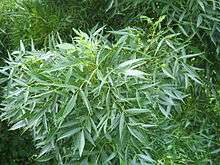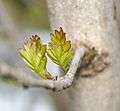Fraxinus angustifolia
| Fraxinus angustifolia | |
|---|---|
 | |
| Foliage of subsp. oxycarpa | |
| Scientific classification | |
| Kingdom: | Plantae |
| (unranked): | Angiosperms |
| (unranked): | Eudicots |
| (unranked): | Asterids |
| Order: | Lamiales |
| Family: | Oleaceae |
| Genus: | Fraxinus |
| Species: | F. angustifolia |
| Binomial name | |
| Fraxinus angustifolia Vahl | |
 | |
| Distribution map | |
| Synonyms | |

Fraxinus angustifolia (narrow-leafed ash) is a species of Fraxinus native to central and southern Europe, northwest Africa, and southwest Asia.[1][2]
Description
It is a medium-sized deciduous tree growing to 20–30 m tall with a trunk up to 1.5 m diameter. The bark is smooth and pale grey on young trees, becoming square-cracked and knobbly on old trees. The buds are pale brown, which readily distinguishes it from the related Fraxinus excelsior (black buds) even in winter. The leaves are in opposite pairs or whorls of three, pinnate, 15–25 cm long, with 3-13 leaflets; the leaflets being distinctively slender, 3–8 cm long and 1-1.5 cm broad. The flowers are produced in inflorescences which can be male, hermaphrodite or mixed male and hermaphrodite. The male and hermaphrodite flowers occur on all individuals, i.e. all trees are functionally hermaphrodite. Flowering occurs in early spring. The fruit when fully formed is a samara 3–4 cm long, the seed 1.5–2 cm long with a pale brown wing 1.5–2 cm long.[2][3][4][5]

Variation
There are four subspecies, treated as distinct species by some authors:[1][2]
- Fraxinus angustifolia subsp. angustifolia. Western Europe north to France, northwest Africa. Leaves with 7–13 leaflets; leaflets hairless beneath.
- Fraxinus angustifolia subsp. oxycarpa (M.Bieb. ex Willd.) Franco & Rocha Afonso (syn. F. oxycarpa M.Bieb. ex Willd.). Caucasian ash. Eastern Europe north to the Czech Republic, southwest Asia east to northern Iran. Leaves with 3–9 leaflets; leaflets with white hairs on the lower half of the midribs.
- Fraxinus angustifolia subsp. syriaca Middle East and West Asia.
- Fraxinus angustifolia subsp. danubialis (described by Zdeněk Pouzar) Middle Europe.
Cultivars
of Fraxinus angustifolia subsp. angustifolia
- 'Pendula Vera', True weeping narrow-leafed ash.
of Fraxinus angustifolia subsp. oxycarpa
- 'Raywood'. This cultivar is commonly planted as an ornamental tree in temperate regions. It has notable autumn colour, but has the major drawback of very brittle branches.
Uses
In Sicily, it is cultivated as a source of a plant sap product called manna (see Fraxinus ornus).[6]
Weed potential
Fraxinus angustifolia subsp. angustifolia has become a weed in many parts of Australia, where it is known as Desert Ash. It has been widely planted as a street and park tree, and has spread to native bushland and grasslands, as well as stream banks and drainage lines, out-competing native plants for moisture, light and nutrients.[7][8]
Gallery
| Wikimedia Commons has media related to Fraxinus angustifolia. |
 Leaves of subsp. oxycarpa
Leaves of subsp. oxycarpa Specimen of 'Raywood', typically showing several broken branches
Specimen of 'Raywood', typically showing several broken branches Young spring leaves of subsp. angustifolia, known as Desert Ash in Australia, where it is classed as a weed.[7]
Young spring leaves of subsp. angustifolia, known as Desert Ash in Australia, where it is classed as a weed.[7] New leaves of subsp. angustifolia
New leaves of subsp. angustifolia Characteristic brown buds
Characteristic brown buds
References
- 1 2 Flora Europaea: Fraxinus angustifolia
- 1 2 3 Rushforth, K. (1999). Trees of Britain and Europe. Collins ISBN 0-00-220013-9.
- ↑ Mitchell, A. F. (1974). A Field Guide to the Trees of Britain and Northern Europe. Collins ISBN 0-00-212035-6
- ↑ Mitchell, A. F. (1982). The Trees of Britain and Northern Europe. Collins ISBN 0-00-219037-0
- ↑ Bean, W. J. (1978). Trees and Shrubs Hardy in the British Isles 8th ed., vol. 2. John Murray ISBN 0-7195-2256-0.
- ↑ Production of manna in Sicily (visited December 21, 2009)
- 1 2 "Desert ash". Weeds Australia. Retrieved 2008-06-11.
- ↑ "Desert Ash" (PDF). Shire of Yarra Ranges. Retrieved 2015-01-17.